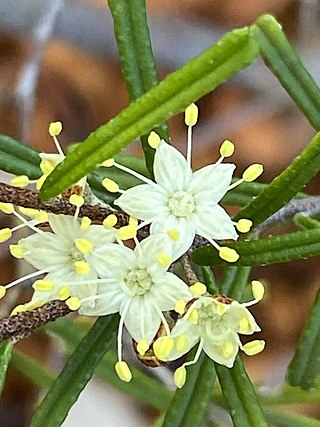
Phebalium daviesii, commonly known as St Helens wax flower or Davies' wax flower, is a species of shrub that is endemic to a restricted area in Tasmania. It is more or less covered with silvery or rust-coloured scales and has narrow wedge-shaped leaves with a notched tip, and umbels of white to cream-coloured, five-petalled flowers.
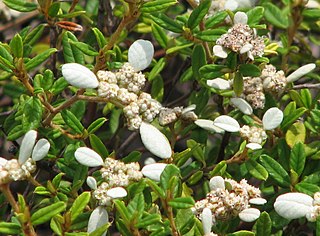
Spyridium vexilliferum, commonly known as winged spyridium, or helicopter bush, is a species of flowering plant in the family Rhamnaceae and is endemic to south-eastern Australia. It is a small, low-lying to erect shrub with linear to narrowly elliptic leaves, and dense heads of small white flowers.

Eucalyptus nitida, commonly known as the Smithton peppermint, is a species of tree or mallee that is endemic to Tasmania. It has varying amounts of loose, fibrous or flaky bark, lance-shaped to curved adult leaves, flower buds in groups of nine to fifteen, white flowers and cup-shaped to hemispherical fruit.

Bossiaea cordigera , commonly known as wiry bossiaea, is a species of flowering plant in the family Fabaceae and is endemic to southern Australia. It is a straggling shrub with wiry branches, egg-shaped to more or less heart-shaped leaves and yellow and red flowers.
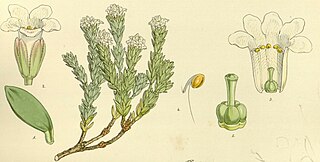
Archeria serpyllifolia is a dense, compact, low growing shrub, that is endemic to Tasmania, Australia, inhabiting the undisturbed alpine areas of southern and south-west Tasmania. This plant is commonly referred to by Australasian naturalists as thyme archeria.

Genoplesium nudiscapum, commonly known as the bare midge orchid, is a species of small terrestrial orchid endemic to Tasmania. It has a single thin leaf fused to the flowering stem and up to twenty small, green and reddish-brown flowers. It was thought to be extinct, since it had not been seen since 1852 but was rediscovered in 2008. The species has also been described as occurring on continental Australia. The species is known as Corunastylis nudiscapa in Tasmania.
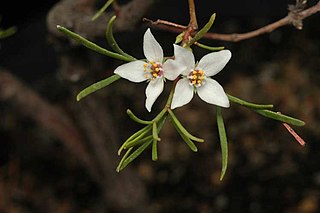
Boronia gunnii, commonly known as Gunn's boronia or Cataract Gorge boronia is a plant in the citrus family Rutaceae and is endemic to Tasmania. It is an erect shrub with compound leaves and pink or white, four-petalled flowers.
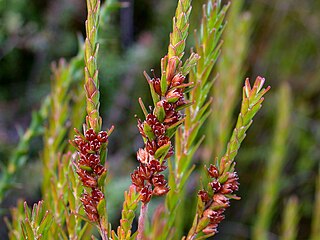
Epacris corymbiflora is a species of flowering plant in the heath family, Ericaceae, and is endemic to Tasmania. It is a low, spreading shrub with elliptic leaves and white, tube-shaped flowers.

Helichrysum pumilum, commonly known as dwarf everlasting, is a rosette herb from the family Asteraceae. It is endemic to Tasmania, where it is commonly found in the West and Southwest of the island state. It is distinctive by its inflorescence, with the flower stalk being densely matted in fine white hairs and the daisy-like flower head having numerous pink or white ray floret-like bracts.

Pultenaea humilis, commonly known as dwarf bush-pea, is a species of flowering plant in the family Fabaceae and is endemic to south-eastern Australia. It is a spreading, often low-lying shrub with branches that are hairy when young, elliptic to lance-shaped leaves with the narrower end towards the base, and yellow to orange and red flowers.
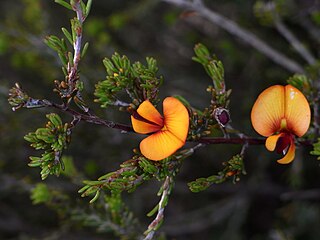
Pultenaea prostrata, commonly known as silky bush-pea, is a species of flowering plant in the family Fabaceae and is endemic to south-eastern Australia. It is a small, rigid, wiry, low-lying or prostrate shrub with cylindrical leaves, and yellow, red and purple-brown flowers.
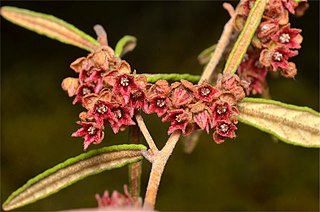
Lasiopetalum membranaceum is a species of flowering plant in the family Malvaceae and is endemic to a small region of eastern Tasmania. It is a low, spreading shrub with thin, rusty-hairy branches, narrow oblong leaves and drooping, star-shaped red to greyish-pink or white flowers.
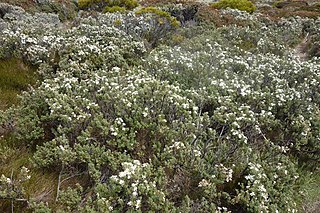
Olearia obcordata is a species of flowering plant in the family Asteraceae and is endemic to Tasmania. It is a shrub that typically grows to a height of less than 3 ft (0.91 m). It usually has wedge-shaped leaves arranged alternately along the branchlets, the narrower end towards the base, with three or five teeth on the ends. The flowers are arranged singly in leaf axils and are few in number with up to six ray florets.
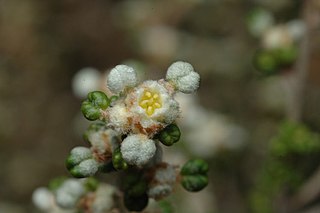
Spyridium lawrencei, commonly known as small-leaf spyridium or small-leaf dustymiller, is a species of flowering plant in the family Rhamnaceae and is endemic to Tasmania. It is an erect, compact or straggling shrub with small, leathery, round to heart-shaped leaves, and dense heads of hairy, cream-coloured flowers.

Cryptandra alpina, commonly known as alpine pearlflower, is a species of flowering plant in the family Rhamnaceae and is endemic to Tasmania. It is a small, prostrate shrub with slender branches, linear leaves, and tube-shaped white flowers arranged singly on the ends of branches.
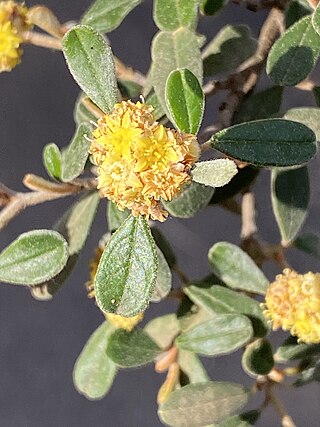
Spyridium obovatum is a species of flowering plant in the family Rhamnaceae and is endemic to Tasmania. It is an upright shrub that typically grows to a height of 0.9–2.5 m and has egg-shaped leaves, the narrower end towards the base, and about 13 mm (0.51 in) long. Small, compact heads of flowers are arranged on the ends of branchlets, the sepals either cream-coloured or yellow, depending on the variety.
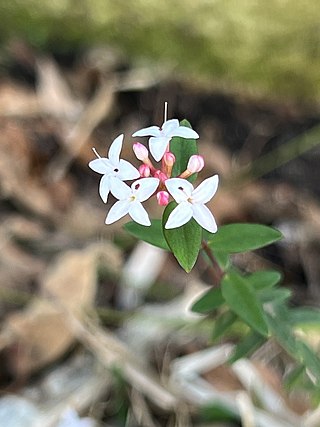
Pimelea filiformis, commonly known as trailing rice flower, is a species of flowering plant in the family Thymelaeaceae and is endemic to Tasmania. It is a prostrate or semi-prostrate undershrub with narrowly elliptic or elliptic leaves and clusters of more or less glabrous, pink or white flowers.
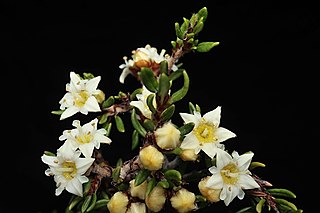
Spyridium ulicinum is a species of flowering plant in the family Rhamnaceae and is endemic to Tasmania. It is a tall shrub with linear to oblong leaves, and single or small groups of white flowers.

Stenanthemum pimeleoides, commonly known as spreading stenanthemum or propellor plant, is a species of flowering plant in the family Rhamnaceae and is endemic to Tasmania. It is a small, prostrate, mat-forming shrub with hairy young stems, egg-shaped leaves with the narrower end towards the base, and densely hairy clusters of tube-shaped flowers surrounded by conspicuous, whitish floral leaves.

Billardiera macrantha is a species of flowering plant in the family Pittosporaceae and is endemic to south-eastern Australia. It is a slender twiner with narrowly elliptic leaves and yellowish-green flowers arranged singly on thin, pendent peduncles. This species is often confused with the similar Tasmanian endemic, Billardiera longiflora.





















